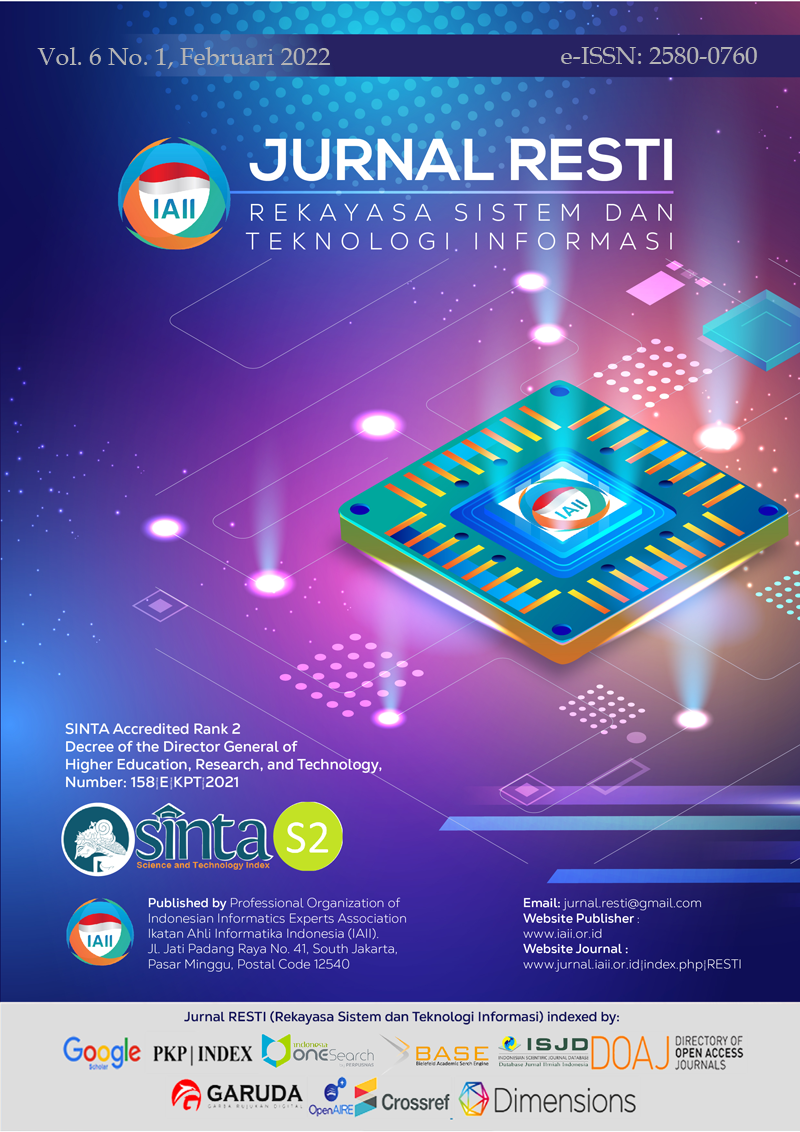Perbandingan Model Proses Algoritma Alpha dan Alpha++ Pada Aplikasi E-commerce
Comparing Model Processes of Alpha and Alpha++ Algorithm in E-Commerce
Abstract
Utilization of information technology is currently growing rapidly in helping activities especially in storing an event log. The activity which is behavior of the user can be analyzed using process mining. The process mining purpose to extract information from event logs on business processes that working. Discovery technique is used in this research. The purpose of this study is to compare two algorithms applied by creating an e-commerce application that is aware of the processes. E-commerce applications require event logs to read the behavior of visitor activities against the application. This research method starts from understanding the business processes that working, then designing a website by creating the application used. Furthermore, data collection through applications that are promoted through social media. The application will be recorded user activity and formed an event log. The event log that formed then discovered using alpha and alpha++ algorithms by utilizing the ProM Lite 1.2 tools. The evaluation results show that the alpha algorithm has shortcomings, namely length one loop, length two loop and non-free choice. And the alpha++ algorithm fixed this deficiency.
Downloads
References
A. N. Anastasia and I. Handriani, “Aplikasi Sistem Order Jasa Graphic Designer Berbasis Web Pada PT. Decorner,” J. Ilm. FIFO, vol. 10, no. 1, p. 87, 2018, doi: 10.22441/fifo.v10i1.2943.
S. Kosasi, “Perancangan Sistem E-commerce Untuk Memperluas Pasar Produk Oleh-Oleh Khas Pontianak,” Snastia, vol. 2015, no. Oktober, pp. 110–119, 2015.
B. Jokonowo, R. Sarno, S. Rochimah, and B. Priambodo, “Process mining: Measuring key performance indicator container dwell time,” Indones. J. Electr. Eng. Comput. Sci., vol. 16, no. 1, pp. 401–411, 2019, doi: 10.11591/ijeecs.v16.i1.pp401-411.
W. M. P. Van Der Aalst, “Process-aware information systems: Lessons to be learned from process mining,” Lect. Notes Comput. Sci. (including Subser. Lect. Notes Artif. Intell. Lect. Notes Bioinformatics), vol. 5460 LNCS, no. January 2009, pp. 1–26, 2009, doi: 10.1007/978-3-642-00899-3_1.
D. T. Nguyen and J. E. Jung, “Real-time event detection for online behavioral analysis of big social data,” Futur. Gener. Comput. Syst., vol. 66, pp. 137–145, 2017, doi: 10.1016/j.future.2016.04.012.
R. Adhim, M. A. Shiddiq, F. F. Ghizbunaza, and M. A. Yaqin, “Process Discovery pada Event log Permainan Hay Day menggunakan Algoritma Inductive Miner,” Semin. Nas. Inov. dan Apl. Teknol. di Ind. 2019, no. February, pp. 66–73, 2019.
D. Reißner, A. Armas-Cervantes, R. Conforti, M. Dumas, D. Fahland, and M. La Rosa, “Scalable alignment of process models and event logs: An approach based on automata and S-components,” Inf. Syst., vol. 94, p. 101561, 2020, doi: 10.1016/j.is.2020.101561.
A. Hermawan, “Business Process Context Analysis Based on ‘Event log,’” J. Penelit. dan Pengemb. Komun. dan Inform., vol. 4, no. 3, p. 122699, 2014.
H. Rizqifaluthi and M. A. Yaqin, “Process mining Akademik Sekolah menggunakan RapidMiner,” Matics, vol. 10, no. 2, p. 47, 2019, doi: 10.18860/mat.v10i2.5158.
P. Nafasa, I. Waspada, N. Bahtiar, and A. Wibowo, “Implementation of Alpha Miner Algorithm in Process mining Application Development for Online Learning Activities Based on MOODLE Event log Data,” ICICOS 2019 - 3rd Int. Conf. Informatics Comput. Sci. Accel. Informatics Comput. Res. Smarter Soc. Era Ind. 4.0, Proc., no. October, 2019, doi: 10.1109/ICICoS48119.2019.8982384.
R. Sarno, K. R. Sungkono, M. Taufiqulsa’di, H. Darmawan, A. Fahmi, and K. Triyana, “Improving efficiency for discovering business processes containing invisible tasks in non-free choice,” J. Big Data, vol. 8, no. 1, 2021, doi: 10.1186/s40537-021-00487-x.
A. K. A. De Medeiros, W. M. P. Van Der Aalst, and A. J. M. M. Weijters, “Workflow Mining: Current Status and Future Directions,” Lect. Notes Comput. Sci. (including Subser. Lect. Notes Artif. Intell. Lect. Notes Bioinformatics), vol. 2888, no. i, pp. 389–406, 2003, doi: 10.1007/978-3-540-39964-3_25.
Y. A. Effendi and R. Sarno, “Parallel process discovery using a new Time-Based Alpha++ Miner,” IIUM Eng. J., vol. 21, no. 1, pp. 126–141, 2020, doi: 10.31436/iiumej.v21i1.1173.
R. Accorsi, M. Ullrich, and W. M. P. Van Der Aalst, Process mining Data Science In Action Second Edition, vol. 35, no. 5. 2012.
A. K. A. de Medeiros, B. F. van Dongen, W. M. P. van der Aalst, and A. J. M. M. Weijters, “Process mining: Extending the a algorithm to mine short loops,” BETA Work. Pap. Ser., 2004.
L. Wen, W. M. P. Van Der Aalst, J. Wang, and J. Sun, “Mining process models with non-free-choice constructs,” Data Min. Knowl. Discov., vol. 15, no. 2, pp. 145–180, 2007, doi: 10.1007/s10618-007-0065-y.
Afina Lina Nurlaili and Agung Mustika Rizki, “Analisis Kualitas Model Proses dalam Implementasi Process mining : Literature Review,” J. Comput. Electron. Telecommun., vol. 1, no. 2, pp. 1–10, 2021, doi: 10.52435/complete.v1i2.74.
H. W. Sun, W. Liu, L. Qi, Y. Y. Du, X. Ren, and X. Y. Liu, “A process mining algorithm to mixed multiple-concurrency short-loop structures,” Inf. Sci. (Ny)., vol. 542, pp. 453–475, 2021, doi: 10.1016/j.ins.2020.07.003.
D. Yue, X. Wu, H. Wang, and J. Bai, “A review of process mining algorithms,” BMEI 2011 - Proc. 2011 Int. Conf. Bus. Manag. Electron. Inf., vol. 5, no. 70872082, pp. 181–185, 2011, doi: 10.1109/ICBMEI.2011.5914454.
Copyright (c) 2022 Jurnal RESTI (Rekayasa Sistem dan Teknologi Informasi)

This work is licensed under a Creative Commons Attribution 4.0 International License.
Copyright in each article belongs to the author
- The author acknowledges that the RESTI Journal (System Engineering and Information Technology) is the first publisher to publish with a license Creative Commons Attribution 4.0 International License.
- Authors can enter writing separately, arrange the non-exclusive distribution of manuscripts that have been published in this journal into other versions (eg sent to the author's institutional repository, publication in a book, etc.), by acknowledging that the manuscript has been published for the first time in the RESTI (Rekayasa Sistem dan Teknologi Informasi) journal ;








